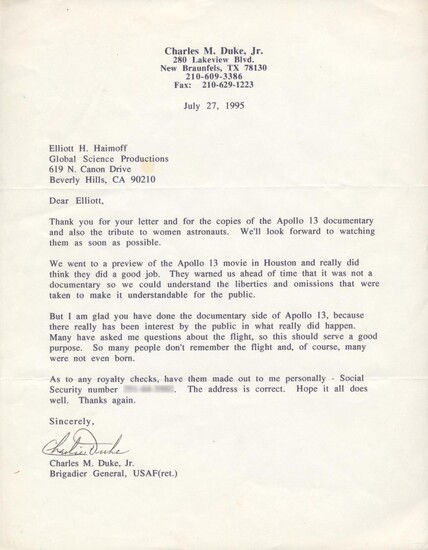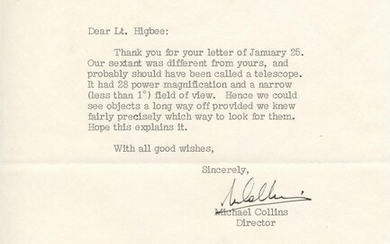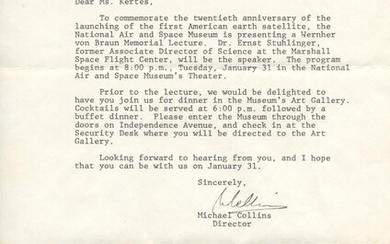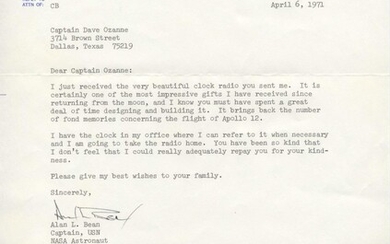TYPED LETTER ***Signed***
By Duke, Charles Charlie
TYPED LETTER personally signed "Charlie Duke" in black ink. This letter in on Charles M. Duke, Jr. letterhead, measures 8.5" X 11" and is dated July 27, 1995. Letter has normal mailing folds otherwise in fine condition. Letter states, "Dear Elliott, Thank you for your letter and for the copies of the Apollo 13 documentary and also the tribute to women astronauts. We'll look forward to watching them as soon as possible. We went to a preview of the Apollo 13 movie in Houston and really did think they did a good job. They warned us ahead of time that it was not a documentary so we could understand the liberties and omissions that were taken to make it understandable to the public. But I am glad you have done the documentary side of Apollo 13, because there really has been interest by the public in what really did happen. Many have asked me questions about the flight, so this should serve a good purpose. So many people don't remember the flightand, of course, many were not even born. As to any royalty checks, have them made out to me personally - Social Security number 123-45-6789. The address is correct. Hope it all does well. Thanks again. Sincerely, (signed) Charles M. Duke, Jr. Brigadier General, USAF(ret.) Air Force Test Pilot Charlie Duke became the tenth person to walk on the Moon when he was lunar module pilot of the Apollo 16 mission in April 1972. Duke and Commander John Young landed their lunar module "Orion" on the Cayley Plains near the crater Descartes six hours later than scheduled because of problems with the main rocket engine of their command module "Casper." Concern over the engine forced them to shorten their planned flight by a day, but Duke and Young nevertheless spent almost three days on the lunar surface, including nearly 21 hours outside Orion. Apollo 16 was the second of the "J" Type missions, utilizing a modified version of the spacecraft used for the first three lunar landings. The J type spacecraft allowed crews to stay on the lunar surface for extended periods of time. The Portable Life Support Systems (PLSS) doubled the capacity of those first used by Aldrin and Armstrong during Apollo 11. Apollo 16 also had the distinction of being the second mission to feature the lunar rover, an electrically-powered vehicle that allowed the two astronauts to travel much greater distances than before on the lunar surface. Charles Moss Duke, Jr., was born October 3, 1935, in Charlotte, North Carolina. He attended the U.S. Naval Academy, graduating in [246] 1957 with a B.S. degree in Naval Sciences. In 1964, he earned an M.S. in aeronautics and astronautics from the Massachusetts Institute of Technology. After pilot training, Duke spent three years with the 526th Interceptor Squadron at Ramstein, Germany. He attended the USAF Aerospace Research Pilot School at Edwards Air Force Base, California, in 1965, and was an instructor there when selected by NASA. As a pilot, Duke logged 4,200 hours of flying time, including 3,600 hours in jets. Duke was one of 19 members of the fifth class (Group 5) of astronauts selected by NASA in April 1966. Calling themselves the "Original 19," this group of astronauts was eligible for Apollo missions, but were left out of the Gemini program rotation. Of the 17 that eventually flew, only three did not go into space on Apollo-related missions. Duke entered the "official" mission rotation as a member of the support crew for Apollo 10. He also served as back-up lunar module pilot on Apollo 13 and 17. Duke was also Capcom on the White Team during the first lunar landing mission. Following the Apollo program, Duke worked on Space Shuttle development for several years before resigning from NASA on January 1, 1976, and from Air Force active duty.
Publication year: 1995
Vendor: Legends In History
Buy Now on
By Duke, Charles Charlie
TYPED LETTER personally signed "Charlie Duke" in black ink. This letter in on Charles M. Duke, Jr. letterhead, measures 8.5" X 11" and is dated July 27, 1995. Letter has normal mailing folds otherwise in fine condition. Letter states, "Dear Elliott, Thank you for your letter and for the copies of the Apollo 13 documentary and also the tribute to women astronauts. We'll look forward to watching them as soon as possible. We went to a preview of the Apollo 13 movie in Houston and really did think they did a good job. They warned us ahead of time that it was not a documentary so we could understand the liberties and omissions that were taken to make it understandable to the public. But I am glad you have done the documentary side of Apollo 13, because there really has been interest by the public in what really did happen. Many have asked me questions about the flight, so this should serve a good purpose. So many people don't remember the flightand, of course, many were not even born. As to any royalty checks, have them made out to me personally - Social Security number 123-45-6789. The address is correct. Hope it all does well. Thanks again. Sincerely, (signed) Charles M. Duke, Jr. Brigadier General, USAF(ret.) Air Force Test Pilot Charlie Duke became the tenth person to walk on the Moon when he was lunar module pilot of the Apollo 16 mission in April 1972. Duke and Commander John Young landed their lunar module "Orion" on the Cayley Plains near the crater Descartes six hours later than scheduled because of problems with the main rocket engine of their command module "Casper." Concern over the engine forced them to shorten their planned flight by a day, but Duke and Young nevertheless spent almost three days on the lunar surface, including nearly 21 hours outside Orion. Apollo 16 was the second of the "J" Type missions, utilizing a modified version of the spacecraft used for the first three lunar landings. The J type spacecraft allowed crews to stay on the lunar surface for extended periods of time. The Portable Life Support Systems (PLSS) doubled the capacity of those first used by Aldrin and Armstrong during Apollo 11. Apollo 16 also had the distinction of being the second mission to feature the lunar rover, an electrically-powered vehicle that allowed the two astronauts to travel much greater distances than before on the lunar surface. Charles Moss Duke, Jr., was born October 3, 1935, in Charlotte, North Carolina. He attended the U.S. Naval Academy, graduating in [246] 1957 with a B.S. degree in Naval Sciences. In 1964, he earned an M.S. in aeronautics and astronautics from the Massachusetts Institute of Technology. After pilot training, Duke spent three years with the 526th Interceptor Squadron at Ramstein, Germany. He attended the USAF Aerospace Research Pilot School at Edwards Air Force Base, California, in 1965, and was an instructor there when selected by NASA. As a pilot, Duke logged 4,200 hours of flying time, including 3,600 hours in jets. Duke was one of 19 members of the fifth class (Group 5) of astronauts selected by NASA in April 1966. Calling themselves the "Original 19," this group of astronauts was eligible for Apollo missions, but were left out of the Gemini program rotation. Of the 17 that eventually flew, only three did not go into space on Apollo-related missions. Duke entered the "official" mission rotation as a member of the support crew for Apollo 10. He also served as back-up lunar module pilot on Apollo 13 and 17. Duke was also Capcom on the White Team during the first lunar landing mission. Following the Apollo program, Duke worked on Space Shuttle development for several years before resigning from NASA on January 1, 1976, and from Air Force active duty.
Publication year: 1995
Vendor: Legends In History







